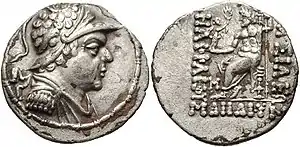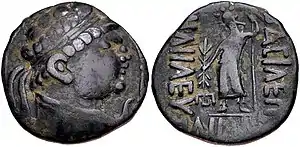Heliocles I
Heliocles (Greek: Ἡλιοκλῆς; reigned 145–130 BCE) was a Greco-Bactrian king, relative (son or brother) and successor of Eucratides the Great, and considered the last Greek king to reign over the Bactrian country. His reign was a troubled one; according to Roman historian Justin, Eucratides was murdered by his son and co-ruler, though Justin fails to name the perpetrator. The patricide might have led to instability, even civil war, which caused the Indian parts of the empire to be lost to Indo-Greek king Menander I and southern Bactria to be lost to the Yuezhi.

Obv: Bust of Heliocles
Rev: Zeus standing, with thunderbolt and sceptre. Greek legend: ΒΑΣΙΛΕΩΣ ΔΙΚΑΙΟΥ ΗΛΙΟΚΛΕΟΥΣ (BASILEOS DIKAIOU HELIOKLEOUS) "Of King Heliocles the Just".

Obv: Bust of Heliocles helmetted and in uniform.
Rev: Zeus standing, with thunderbolt and sceptre. Greek legend: ΒΑΣΙΛΕΩΣ ΔΙΚΑΙΟΥ ΗΛΙΟΚΛΕΟΥΣ (BASILEOS DIKAIOU HELIOKLEOUS) "Of King Heliocles the Just".

Yuezhi invasion
From 130 BCE a nomadic people, the Yuezhi, started to invade Bactria from the north and we could assume that Heliocles was killed in battle during this invasion. Details from Chinese sources seem to indicate that the nomad invasion did not end civilisation in Bactria entirely. Hellenised cities continued to exist for some time, and the well-organised agricultural systems were not demolished.
The Yuezhi would copy and adapt the coin types of Heliokles for a long time.
Continuation of the Indo-Greek kingdom
Even if this was the end of the original Greco-Bactrian kingdom, the Greeks continued to rule in northwestern India to the end of the 1st century BCE, under the Indo-Greek Kingdom. It is unclear whether the dynasty of Eucratides was extinguished with the death of Heliocles I or if members of the family emigrated eastwards. Several later Indo-Greek kings, including Heliocles II, struck coins which could be associated with the dynasty.
References
- The Shape of Ancient Thought. Comparative studies in Greek and Indian Philosophies by Thomas McEvilley (Allworth Press and the School of Visual Arts, 2002) ISBN 1-58115-203-5
- Buddhism in Central Asia by B. N. Puri (Motilal Banarsidass Pub, January 1, 2000) ISBN 81-208-0372-8
- The Greeks in Bactria and India, W. W. Tarn, Cambridge University Press.
External links
- Coins of Heliocles
- More coins of Heliocles
- Catalogue of the Coins of Heliocles I and Scythian Imitations
| Preceded by Eucratides |
Greco-Bactrian King (in Eastern Bactria) 145 – 130 BCE |
Succeeded by Zoilos I |
- O. Bopearachchi, "Monnaies gréco-bactriennes et indo-grecques, Catalogue raisonné", Bibliothèque Nationale, Paris, 1991, p.453
- Quintanilla, Sonya Rhie (2 April 2019). "History of Early Stone Sculpture at Mathura: Ca. 150 BCE - 100 CE". BRILL – via Google Books.